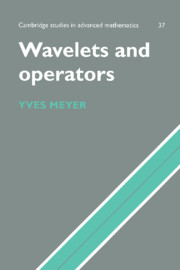Book contents
- Frontmatter
- Contents
- Dedication
- Preface to the English Edition
- Introduction
- 1 Fourier series and integrals, filtering and sampling
- 2 Multiresolution approximations of L2(ℝn)
- 3 Orthonormal wavelet bases
- 4 Non-orthogonal wavelets
- 5 Wavelets, the Hardy space H1 and its dual BMO
- 6 Wavelets and spaces of functions and distributions
- Bibliography
- New references on wavelets and their applications
- Index
2 - Multiresolution approximations of L2(ℝn)
Published online by Cambridge University Press: 24 December 2009
- Frontmatter
- Contents
- Dedication
- Preface to the English Edition
- Introduction
- 1 Fourier series and integrals, filtering and sampling
- 2 Multiresolution approximations of L2(ℝn)
- 3 Orthonormal wavelet bases
- 4 Non-orthogonal wavelets
- 5 Wavelets, the Hardy space H1 and its dual BMO
- 6 Wavelets and spaces of functions and distributions
- Bibliography
- New references on wavelets and their applications
- Index
Summary
Introduction
Orthonormal wavelet bases have only been available for the last few years, but similar constructions were previously used in mathematics, theoretical physics and signal processing.
It is interesting and surprising that all these related constructions saw the light of day almost simultaneously (in fact, during the 1980s) in constructive field theory, in the geometry of Banach spaces and even in the processing of signals obtained during prospecting trips of the Elf-Aquitaine group (Morlet's work on reflection seismology).
Research workers in the various specialities were hoping to find practical algorithms for decomposing arbitrary functions into sums of special functions which would combine the advantages of the trigonometric and the Haar systems. These systems stand at two extremes, in the following sense: the functions of the trigonometric system are exactly localized by frequency, that is, in the Fourier variable, but have no precise localization in space. On the other hand, the functions of the Haar system (whose definition we recall in Chapter 3) are perfectly localized in space (the x variable) but are badly localized in the Fourier variable (the ξ variable). This is due to two defects of the functions of the Haar system: their lack of regularity and their lack of oscillation.
R. Balian has given the following justification for trying to find Hilbert bases which are simultaneously well-localized in space and in the Fourier variable. “In the theory of communications, it is appropriate to represent an oscillatory signal as the superposition of elementary wavelets possessing both a well-defined frequency and a localization in time.
- Type
- Chapter
- Information
- Wavelets and Operators , pp. 18 - 65Publisher: Cambridge University PressPrint publication year: 1993



